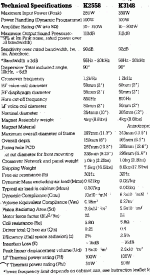Hi everyone. I have a pair of Tannoy LGM - Little Gold Monitors. I have been fairly reliably informed that these contain the K3149/8 driver, the same as the Edinburgh HE.
After convincing my wife that we really, really need better cabinets she has agreed to me building some Edinburgh replicas
I know the basics of the design; 200L internal, H=1020mm, W=660mm, D=420mm. 18mm material.
Can anyone help me calculate the "Distributed Ports" please?
Tannoy Edinburgh
Thanks in advance,
Lee.
After convincing my wife that we really, really need better cabinets she has agreed to me building some Edinburgh replicas
I know the basics of the design; 200L internal, H=1020mm, W=660mm, D=420mm. 18mm material.
Can anyone help me calculate the "Distributed Ports" please?
Tannoy Edinburgh
Thanks in advance,
Lee.
Also, some of this was discussed here:
http://www.diyaudio.com/forums/showthread.php?s=&postid=1385675#post1385675
Cheers,
Lee.
http://www.diyaudio.com/forums/showthread.php?s=&postid=1385675#post1385675
Cheers,
Lee.
Qts=.4
FS=32Hz
VAS=9.54ft3
Re=5.6R
BL=22
SPL=92dB
12 inch driver
Apparently .......
In 200L (+10% for lining / stuffing) seems to work well with a port
tuned to around 28Hz. THe only point of slots I guess would be
some damping of a higher tuning frequency - cannot see the point.
If you make the port out of a number of small ports, lets say 5, then
the bass can be tuned by blocking off / foam bunging one or two.
For maximally flat in 200L port tuning is 32Hz.
If 5 vents = 32Hz, 4 vents = 28.5Hz and 3 = 25hz.
 /sreten.
/sreten.
FS=32Hz
VAS=9.54ft3
Re=5.6R
BL=22
SPL=92dB
12 inch driver
Apparently .......
In 200L (+10% for lining / stuffing) seems to work well with a port
tuned to around 28Hz. THe only point of slots I guess would be
some damping of a higher tuning frequency - cannot see the point.
If you make the port out of a number of small ports, lets say 5, then
the bass can be tuned by blocking off / foam bunging one or two.
For maximally flat in 200L port tuning is 32Hz.
If 5 vents = 32Hz, 4 vents = 28.5Hz and 3 = 25hz.
Hi Sreten, thanks for the advice. From what I've read about onken/slotted port cabs, they're known for giving a faster transient response.
I also like the idea that you can tune the bass by closing the ports up . I think that on the Edinburgh, you can close or open the ports at will with a slider, although I may be wrong.
Is there any way that the port or vent length can be calculated? I am a relative noob to speaker building, having only built some FR125 mini-onken's and a diy centre speaker, so I'm not perfectly aware of how to calculate vents etc. without a computer program.
Regards, Lee.
I also like the idea that you can tune the bass by closing the ports up . I think that on the Edinburgh, you can close or open the ports at will with a slider, although I may be wrong.
Is there any way that the port or vent length can be calculated? I am a relative noob to speaker building, having only built some FR125 mini-onken's and a diy centre speaker, so I'm not perfectly aware of how to calculate vents etc. without a computer program.
Regards, Lee.
Here are three speaker port calculators -
Box Tuning calculator-
http://www.2k4civic.com/portcalculator.html
Linear Team Vent Calculator -
http://www.linearteam.dk/default.aspx?pageid=ventcalculator
Linear Team is also the maker of the free WinISD speaker design software which is a very popular program used by many people in this forum.
Calculate Your Vent Length-
http://www.carstereo.com/help2/Articles.cfm?id=31
Scroll down to the second Calculator.
There are different philosophies about where you should tune the cabinet. Some say right at the resonant frequency of the speaker, other say just above the resonant frequency, today many modern speaker makers tune below the speaker's resonant frequency. As a broad and general rule of thumb, you can't go wrong with 30hz.
Also, keep in mind that today, most speaker designers recommend using flared ports. Usually this means the end of the ports are rounded off with a quarter round router bit. But this does affect the length. I think the true working length does not include the flares.
Scroll down near the bottom of this page to see an illustration of a flared port.
http://www.geocities.com/f4ier/vents.htm
Also, today most people are making their ports out of white PVC plumbing pipe. It's cheap, very ridged, and readily available. Try to make your ports match the inside diameter of standard plumbing pipe.
steve/bluewizard
Box Tuning calculator-
http://www.2k4civic.com/portcalculator.html
Linear Team Vent Calculator -
http://www.linearteam.dk/default.aspx?pageid=ventcalculator
Linear Team is also the maker of the free WinISD speaker design software which is a very popular program used by many people in this forum.
Calculate Your Vent Length-
http://www.carstereo.com/help2/Articles.cfm?id=31
Scroll down to the second Calculator.
There are different philosophies about where you should tune the cabinet. Some say right at the resonant frequency of the speaker, other say just above the resonant frequency, today many modern speaker makers tune below the speaker's resonant frequency. As a broad and general rule of thumb, you can't go wrong with 30hz.
Also, keep in mind that today, most speaker designers recommend using flared ports. Usually this means the end of the ports are rounded off with a quarter round router bit. But this does affect the length. I think the true working length does not include the flares.
Scroll down near the bottom of this page to see an illustration of a flared port.
http://www.geocities.com/f4ier/vents.htm
Also, today most people are making their ports out of white PVC plumbing pipe. It's cheap, very ridged, and readily available. Try to make your ports match the inside diameter of standard plumbing pipe.
steve/bluewizard
- Status
- This old topic is closed. If you want to reopen this topic, contact a moderator using the "Report Post" button.
